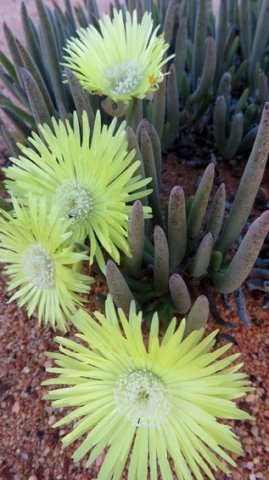Cephalophyllum

Cephalophyllum is a genus of compact, cushion-forming leaf succulents in the Aizoaceae or mesemb family. The prostrate or decumbent, creeping branches range from woody to spongy, the plant rooting from suckers. The stems often have notable internodes between the opposite leaves, only few species are erect and shrubby.
The three-angled, spindle-shaped or nearly cylindrical leaves often end in pointed tips. Leaf surfaces are smooth in shades of green and grey-green. The generic name, Cephalophyllum, is derived from the Greek words kephale meaning head and phyllon meaning leaf, referring to the compact heads of leaves often present.
The flowers commonly appear in groups of up to three, sometimes solitary at stem-tips on longish pedicels and sometimes with bracts present.
There are five fleshy sepals and numerous linear petals in one or a few rows that spread from around noon to sunset, the flowering happening in winter. The petals are linear, coloured white, yellow, orange, red, copper or purple, sometimes brightly bicoloured.
The numerous stamens are erect and spreading, often differently coloured to the petals. Staminodes are present in one species only. The nectary is a finely notched ring of glands in the flower base. The ovary has a raised rim around the 10 to 21 feathery stigmas.
The fruit is a capsule with as many locules as there were stigmas, opening when wet. The roof of the locule or covering membrane bulges, flanked by broad valve wings. The expanding keels are parallel and there is a large closing body. The seeds are small and brown, ovoid to pear-shaped.
There are 33 Cephalophyllum species, all found in the west and southwest of South Africa and the southwest of Namibia, the winter rain region.
The species in picture is Cephalophyllum loreum (Leistner, (Ed.), 2000; Smith, et al, 1998).

